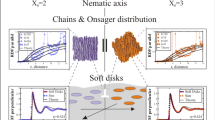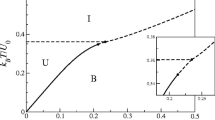Abstract
Based on a solution of the polymer excluded volume problem, a technique is proposed to estimate some parameters at the isotropic-nematic liquid crystal phase transition (the product of the volume fraction of hard sticks and the ratio of the stick length, L, to its diameter, D; the maximum value of this ratio at which one cannot regard the stick as hard). The critical exponents are estimated. The transition of a swelling polymer coil to ideal is revealed as the polymerization degree of a macromolecule increases. The entanglement concentration obtained agrees with experimental data for polymers with flexible chains. The number of monomers between neighbor entanglements is assumed to be the ratio L/D. A comparison of the theory with other ones and recent experimental data is made.
Similar content being viewed by others
References
M.E. Fisher: “Shape of a Self-Avoiding Walk or Polymer Chain”, J. Chem. Phys., Vol. 44, (1966), pp. 616–622.
P.-G. de Gennes: “Exponents for the Excluded Volume Problem as Derived by the Wilson Method”, Phys. Lett., Vol. 38A, (1972), pp. 339.
K.G. Wilson and J. Kogut: “The renormalization group and the ε-expansion”, Phys. Rep., Vol. 12C, (1974), pp. 75–199.
L.D. Landau and E.M. Lifshitz: Statistical Physics, 3rd ed., Pergamon, Oxford, 1980.
A.Yu. Grosberg and A.R. Khokhlov: Statistical Physics of Macromolecules. American Institute of Physics Press, New York, 1994.
P.-G. de Gennes: Scaling Concepts in Polymer, Physics, Cornell University Press, New York, Ithaca and London, 1979.
A.N. Yakunin: “A Globule in a Stretching Field. The Role of Partial Melting During Drawing of Crystalline Polymers”, Intern. J. Polymeric Mater., Vol. 22, (1993), pp. 57–64.
S. Caracciolo, M.S. Causo, A. Pelissetto: “High-precision determination of the critical exponent γ for self-avoiding walks”, Phys. Rev. E, Vol. 57, (1998), pp. R1215-R1218.
G. Besold, H. Guo, M.J. Zuckermann: “Off-Lattice Monte Carlo Simulation of the Discrete Edwards Model”, J. Polym. Sci.: Part B: Polym. Phys., Vol. 38, (2000), pp. 1053–1068.
J. Zinn-Justin: “Precise determination of critical exponents and equation of state by field theory methods”, Phys. Rep., Vol. 344, (2001), pp. 159–178.
R.P. Wool: “Polymer Entanglements”, Macromolecules, Vol. 26, (1993), pp. 1564–1569.
P.-G. de Gennes: The physics of liquid crystals, Clarendon Press, Oxford, 1974.
A. Brûlet, V. Fourmaux-Demange, J.P. Cotton: “Temperature Dependence of the Conformation of a Comblike Liquid Crystalline Polymer in a N I Nematic Phase”, Macromolecules, Vol. 34, (2001), pp. 3077–3080.
Author information
Authors and Affiliations
About this article
Cite this article
Yakunin, A.N. Nematic ordering problem as the polymer problem of the excluded volume. centr.eur.j.phys. 1, 355–362 (2003). https://doi.org/10.2478/BF02476302
Received:
Revised:
Issue Date:
DOI: https://doi.org/10.2478/BF02476302




